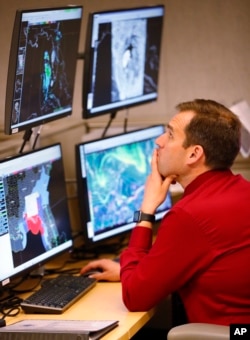An American website reported last month that President Donald Trump asked U.S. government officials to explore using nuclear bombs to stop hurricanes. It claimed that Trump had suggested the targeted use of nuclear bombs to protect the United States against the storms.
The president was quick to deny the Axios website report. He published the denial on Twitter.
“The story by Axios that President Trump wanted to blow up large hurricanes with nuclear weapons prior to reaching shore is ridiculous. I never said this,” he tweeted. He added that the report was “just more fake news.”
While Trump denied suggesting such a plan, he would not have been the first person to propose this idea. In fact, the use of man-made technology have long been explored to destroy or weaken large storms.
The first suggestion of using a nuclear weapon to fight a hurricane reportedly was made during the 1950s. It is said to have come from a U.S. government scientist during the presidency of Dwight Eisenhower.
Government scientists dismiss idea
The U.S. National Oceanic and Atmospheric Administration, or NOAA, predicts hurricanes and other severe weather events. It also works to keep the public informed about such storms.
The scientific agency says it often receives suggestions that nuclear weapons should be used against hurricanes. NOAA addresses the “nuking” of storms on its website. “Needless to say, this is not a good idea,” it says.
NOAA says the first problem with this idea is there is no good evidence that a nuclear bomb would weaken or stop a hurricane. In addition, the agency noted that such a plan ignores the release of radioactive material in a nuclear blast. This material would “fairly quickly move with the trade winds to affect land areas and cause devastating environmental problems,” it said.
In a much deeper scientific exploration of the issue, NOAA said it would be very difficult for explosives to stop the huge amount of energy produced by a large hurricane. It said a fully developed hurricane creates so much energy that it would be equal “to a 10-megaton nuclear bomb exploding every 20 minutes.”
NOAA made an estimate of the amount of energy required to weaken the strength of a Category 5 hurricane to that of a Category 2 storm. It predicted that would require more than 500 million tons of air to hit a storm with a 20-kilometer-wide eye. It would be very difficult to find “a practical way of moving that much air,” the agency noted.
Seeding storm clouds
Another method that was studied for years involved “seeding” the eye of hurricanes. NOAA reports that seeding experiments were carried out from 1962 to 1983 as part of a U.S. government project called STORMFURY.
Scientists used a substance called silver iodide, which can form ice crystals. The goal was to drop silver iodide into hurricane rain clouds. Scientists theorized that the process would weaken wind strength and reduce the storm’s intensity.
But in the end, NOAA decided that cloud seeding had little chance of success. This was mainly because scientists found that “hurricanes contained too much natural ice and too little supercooled water.”
The seeding experiments also failed to differentiate “between the expected results of human intervention and the natural behavior of hurricanes,” NOAA said.
Cooling sea water
Another idea involves cooling waters on the ocean’s surface. A U.S.-based company called Intellectual Ventures says it has developed a water cooling method to weaken hurricanes. It calls the system Salter Sink.
A company video explains the system would use a large pump, powered by ocean waves, to push hot water from the surface down into cooler water below. The hot water would travel through a plastic container known as a Salter Sink. The idea was that the water being forced down would mix with cooler water and then return to the surface to help weaken a hurricane.
A 2012 statement on the Intellectual Ventures website says the system had produced “some interesting early results” and some interest. However, the company said the technology will “require much more extensive testing and research that’s better suited for a university or government research group.”
Several studies have predicted that warming waters in the Atlantic Ocean are expected to increase the number of major hurricanes in the coming years. Currently, the United States and neighboring countries are now entering the most active part of the hurricane season.
It remains to be seen whether the number and size of future storms will fuel additional research into new solutions aimed at stopping them.
I’m Bryan Lynn.
Bryan Lynn wrote this story for VOA Learning English, based on reports from NOAA, The Associated Press, Agence France-Presse and online sources. George Grow was the editor.
We want to hear from you. Write to us in the Comments section, and visit our Facebook page.
________________________________________________________________
Words in This Story
ridiculous – adj. extremely foolish or unreasonable
fake – adj. false
trade wind – n. a wind blowing almost always from the same direction
devastating – n. causing a lot of damage or destruction
practical – adj. relating to real situations or actions and not just thoughts or ideas
crystal – n. a piece of a substance that has become solid
extensive – adj. large in amount or size
suit – n. to be acceptable or right for someone













